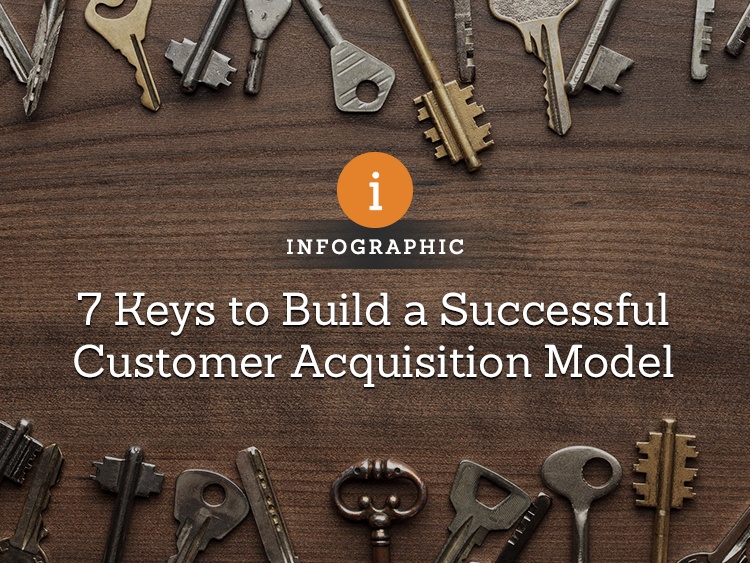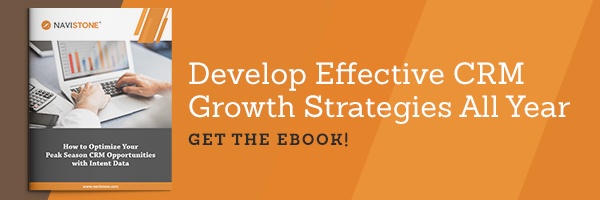The path to customer acquisition can be tricky, but it's one that is well worth investing in. Check out our Infographic below and learn the 5 steps to mastering the...

From leveraging intent data to building customer lifestyle stages, these 7 tips will help you develop an effective customer acquisition strategy.

Introduction:
A carefully curated customer acquisition strategy is essential for any business that takes CRM seriously. Here are seven steps you can take towards attracting new customers - and keeping those customers happy over the long haul.
1) Measure Intent Data
Discover customer clues that signal significant interest. Intent can mean a desire to buy or simply to learn more about your company. The ultimate goal is to identify the reasons behind consumer activity.
- Emails about abandoned online shopping carts are opened more than 40 percent of the time.¹
- More than 60 percent of marketers believe that finding qualified leads is their greatest challenge.¹
2) Build Audiences by Lifestyle Stages
Grouping people by their current lifestyles is far better than using demographics or past purchases. Drill down on what people are most likely to do in the near future. Use audience segmentation to better predict future behavior.
- Only 37 percent of marketers segment their email campaigns based on consumer behavior.²
- Using lifestyle-based segmentation allows you to prepare for your busiest seasons while still keeping your core audience engaged.
- Emails sent to segmented distribution lists were opened 2x as often as those sent to non-segmented lists.³
3) Test Different Marketing Media
Use your off-season months to figure out what approach works for you. Learn how to time your marketing communications so that you get the maximum benefit from every touchpoint. See what works for your audience and let that information be the basis of your campaign.
- Less than 50 percent of email marketers test different subject lines to maximize engagement.¹
- More than 75 percent of people aged 18 and older use both desktop computers and mobile devices to visit eCommerce websites.⁴
- Direct mail response rates in 2016 were 5.3 percent for house lists and 2.9 percent for prospects.⁵
4) Measure, Interpret and Optimize Based on Data
Let data tell the story of your audience. Use data as your ultimate guide for fine-tooling your advertising. Place a high priority on data and leave your preconceived notions to the side.
- Emails segmented by interest groups are opened nearly 75 percent more frequently than generic email blasts.³
- Only 42 percent of social media marketers have the ability to adequately measure their true social media impact.¹
- 87 percent of Millennials like to receive offers through direct mail.⁶
5) Know Your Brand Story
Know who you are and how you get here. Understand what makes you unique. Know how to communicate that to your audience.
- More than 90 percent of customers want to make purchases from a brand they perceive to be authentic.⁷
- 82 percent of people believe that brand strength is a major factor in their buying decision making process.⁷
6) Plan for Individualized Marketing
Create an infrastructure that allows you to see your audience as true individuals. Give people the marketing they want on their terms. Provide individualized offers that speak to that individual’s wants and needs.
- Half of email marketers believe that their ability to individualize emails is their most powerful personalization tactic.¹
- Programmatic postcards allow you to combine individualized marketing with the immediacy of digital marketing and the high response rate of direct mail.
- More than half of modern consumers are willing to exchange personal information for better service.⁸
7) Customer Satisfaction
The best way to get new customers is to please the customers you already have. Wow your current audience, and they’ll be glad to refer others to your company.
- 82 percent of Americans ask for recommendations from others when they’re considering making a purchase.⁹
- 7 out of 8 customers trust online reviews as much as they trust personal recommendations from friends and family.¹⁰
- Consumers spend 31 percent more at businesses that received excellent reviews online.¹⁰
Source
- https://www.iwco.com/blog/2017/01/20/direct-mail-response-rates-and-2016-dma-report/
- https://www.marketingprofs.com/chirp/2017/32547/the-evolution-of-influencer-marketing-infographic
- https://blog.crowdspring.com/2017/01/successful-branding-for-entrepreneurs-statistics/
- https://www.salesforce.com/blog/2017/05/14-retail-customer-experience-stats.html

